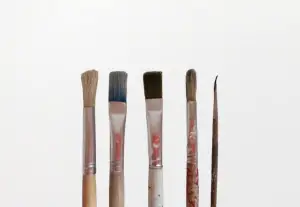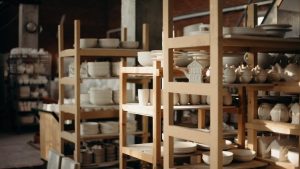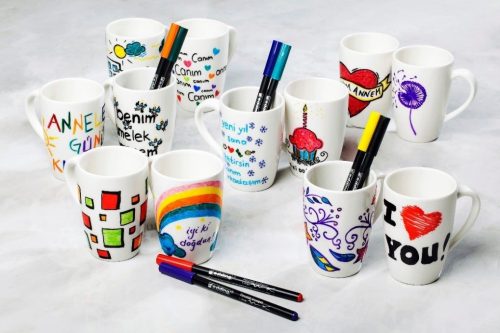Table of Contents
All kinds of brushes and different bristles
Nowadays brushes are made from different materials, either artificial or natural bristles.
Natural bristle brush
The bristles of these brushes are obtained from the Chinese Chungking pig. This animal is characterized by its white fur, which is of excellent quality and durability.
Natural bristle brushes are the most commonly used brushes in the world, typically used for painting all surfaces.
Ox Ear Hair
This type of brush is made from the hair of the ox ear, from the part of the earlobe. The ox was originally born as a bull. The difference is that the ox is castrated and therefore grows much larger than the bull.
Ox-ear hair brushes can be identified by having thick but soft bristles and, in most cases, a dark color, either brown or black.
This type of brush is used for working with materials and techniques such as oil and watercolor.
Pony hair brush
That’s right, this type of brush is made from pony hair. They are widespread and easy to spot because of their dark color, oval shape, and lots of soft bristles.
Pony hair brushes are used for decorating ceramics as well as porcelain.
Squirrel Hair Brush
As the name suggests, this type of brush is made from squirrel hair. The hair is obtained from the tails of squirrels. The different squirrel species also define the different colors.
- Canadian squirrel = gold colored
- Eurasian squirrel = brown
There are even more different colors depending on the species.
The hair of these animals makes the bristles of the brushes soft and fine-tipped, ideal for watercolor painting, ceramics, and porcelain.
Goat Hair Brush
Goat hair brushes are very common and also inexpensive. These are generally used for general purposes, e.g. B. as a make-up brush made. As the name suggests, they are made from goat hair and are easy to spot as they are distinguished by their black and white color.
Kolinsky marten brush
These brushes are made from Kolinsky’s (fire weasel/sable) hair, harvested from the animal’s tail, an animal native to northern Siberia, the Kola Peninsula, and Mongolia.
The hairs of this type of marten make brushes very strong and of excellent quality. In addition, the brush hairs return to their original shape after use, so they last a long time.
This type of brush is used to paint small details with all types of low-viscosity paints such as watercolors, acrylics, and oil paints.
Red marten brush
The red sable is not an animal, but the brush bears this name. The high-quality brushes are made from marten hair. The hair of the marten is shorter than that of the Kolinsky sable. Red sable brushes are ideal for decorating watercolors, porcelain, and ceramics.
Synthetic hair brush
Synthetic brushes have advantages and disadvantages compared to natural products. These brushes are not made from animal hair but from materials such as nylon or polyester.
Teijin synthetic hair brush
This type of brush is one of the most used for painting all kinds of materials. Being a synthetic brush, its bristles are not the softest, but this has the advantage of being able to apply a large amount of paint.
Usually, these brushes are used for processing acrylic and oil paints.
In addition, the bristles are very elastic and resistant. These brushes can be identified, among other things, by the dark color of the bristles and the handle.
You get these brushes with different shapes at the tip i.e. round, flat, etc.
Toray synthetic hair
These synthetic hair brushes differ from the Toray synthetic hair brushes in that they are made of golden bristles and have a short, different colored handle.
The great thing about these brushes is that the bristles are very soft and hardened at the same time, which makes them easy to handle and use with any type of paint.
Types of brushes by shape
Now that you know the types of brushes by their hair, it’s time to look at the types of brushes by their shape. Here we show them to you.
Round brushes
We start with the round brushes, characterized by the fact that their bristles form a semicircle or an oval. In addition, the ferrule is also round. The ferrule is the part that simulates steel or metal before it reaches the bristles.
With these brushes, you can make thin and thick strokes, draw lines and details, highlight shapes, create volume, and fill in or moisten areas.
Flat brush
As the name suggests, this type of brush is characterized by the fact that the bristles are even, forming a straight line at the end of each brush. Flat brushes of every size are available on the market.
Flat brushes can be used to create borders and fills. It is important to know that these brushes have two types of tips that we are going to show you here.
Flat brush with slanted tips
Slanted-tipped flat brushes are those in which the tip is slanted, like markers. This allows you to make either thin or thick strokes.
Flat brush with a round tip
This type of brush is great for painting shapes like flowers and leaves, and it can also be used to mix multiple colors on the same area.
Fan brush
Fan brushes are very easy to identify by the shape of their bristles and when you look at them they look exactly like an open fan.
This type of brush is thin, but perfect when you want to add textures, grass, clouds, foliage, and more for decoration.
Cat tongue brush
No, cat tongue brushes are not made from cat tongue. The cat tongue brush can be recognized by the oval shape of its bristles, which are modeled on a tongue. This type of brush comes in all sizes.
This brush can be used for mixing colors and making various decorative figures.
Paintbrush
This brush type is one of the thickest brushes available. They are characterized by a long stem and many bristles in a straight line and of considerable thickness.
The paintbrush is perfect for applying lots of color to large areas.
Profiler brushes
The fine brushes are suitable for making very fine strokes. What makes these brushes suitable for this type of work is the shape of their bristles, which are very long but thin at the same time.
Brushes for your ceramics
Next, we will introduce you to the brushes that you should have in your pottery workshop.
Round pointed brushes
Round pointed brushes are among the most common brushes used for decorating ceramics. There are different types of these brushes in different sizes and each of them has its specific functions.
Round brush with semi-extended tip
This type of brush is characterized by its thick but elongated tip. These brushes are specifically used for creating very precise details in glazes and ceramic engobes.

Round brush with a long, thin tip
This brush is very popular because the bristles are long and thin. Its possible uses are therefore very diverse.
With this brush, you can work filigree and contour, i.e. draw very thin strokes, from decorative lines to letters or numbers. The best thing about these brushes is that you can use them on materials such as ceramic glazes and engobes, coloring oxides, and glazing.

Medium-length, round, pointed brushes
The medium-length, round, pointed brush is ideal for small details on materials such as ceramic glazes and engobes. It can also be used to make decorations with oxides, dyes, and glazes.

Medium-tipped round brush for profiling
This type of brush cannot be missing in your ceramics workshop because it is ideal for decorating all types of clay in ceramics. It is characterized by being thick at the base of its bristles and ending with a medium-profiled tip.
With this brush, you can fillet, write on and contour with engobes and ceramic glazes. It’s perfect for making straight, long strokes with lots of color without having to keep soaking it.
In addition, you can also use it to handle materials such as gold, platinum, and other types of liquids that you use to decorate your pieces.

Round brush with a small tip
This brush is considered one of the best brushes for decorating ceramics. This is due to its size and shape, which not only allows you to paint with a considerable amount of paint despite its small size but also to fill or mix paint.
And the best part! The small-tipped round brush can be used for engobes, glazes, color oxides, glazes, and many other types of liquids.

Round brush with nib tip
The brush is so named because of the shape of its bristles, which closely resemble the shape of a feather, thick at the bottom and finely pointed at the top.
This type of brush is ideal if you want to decorate with engobes, glazes, coloring oxides, and glazes. Don’t forget that thanks to its feather-shaped tip you can also use it to paint thick parts with edges without them leaking.

Medium-tipped round brush
This type of brush is very similar to the small round brush, the only difference is the size. The uses are the same, namely to draw strokes and decorate with engobes, glazes, colored oxides, glazing, gold, and more, with the difference that this brush is used for larger details.
That’s why this brush is also at the top of the best brushes for decorating ceramics.

Diagonal round brushes with a diagonal tip
To finish off the round pointed brushes, let’s not forget the oblique contouring tip brush.
Thanks to its tip, this brush allows you to make very thin, straight, or curved, continuous strokes. And because it has a long tip, you can also decorate in hard-to-reach places.

Flat brushes
Flat brushes are also a great help when decorating ceramic work.
Small brush with a flat tip
We start with a small flat brush. This type of brush is a must because its shape and size make it ideal for lettering and painting, or for filling in narrow parts of your pieces and figures.
Note that this brush is ideal for processing materials such as engobes, enamels, oxides, and glazes.

Medium flat brush
The medium-sized, flat-tipped brush is suitable for lettering and large and small decorative details. With this brush, you can apply engobes, glazes, coloring oxides, glazes, gold, and platinum.
This type of brush is characterized above all by its flat tip and the length of its bristles, ideal for applying large quantities of liquids to decorate your objects.

Wide brush with a flat tip and soft bristles
Finally, we show you this brush, ideal for decorating landscapes and foliage. Its bristles are soft, flexible, and short, making it the perfect tool for decorating with all types of liquids, from engobes and glazes to oxides, dyes, and glazes.
The thickness of the bristles lends itself perfectly to impromptu decorations rather than linear ones typically used when painting.




